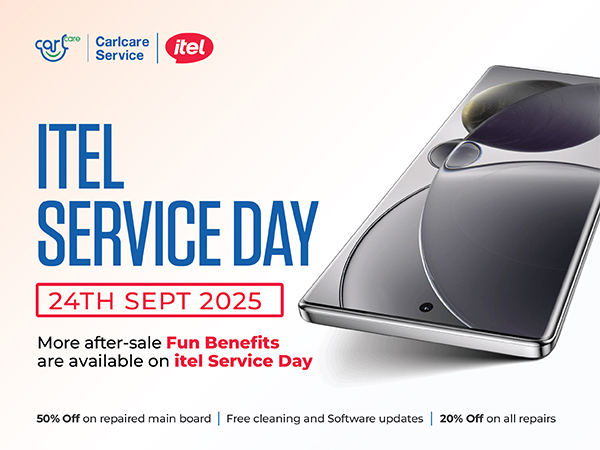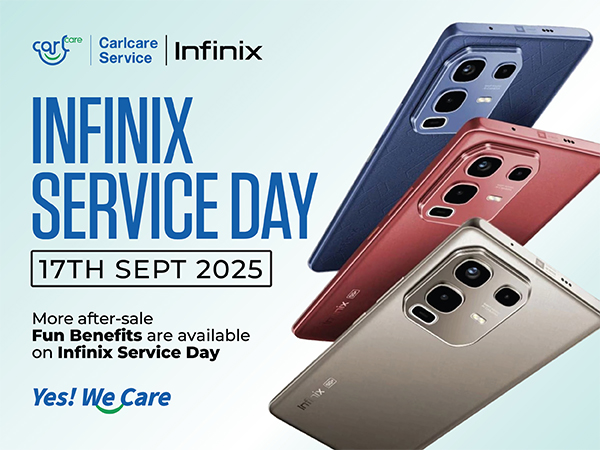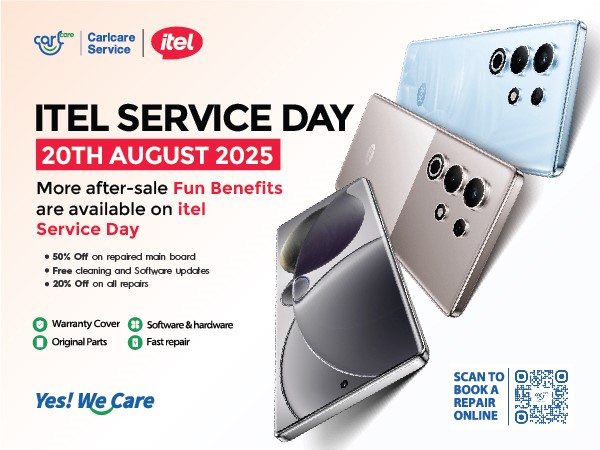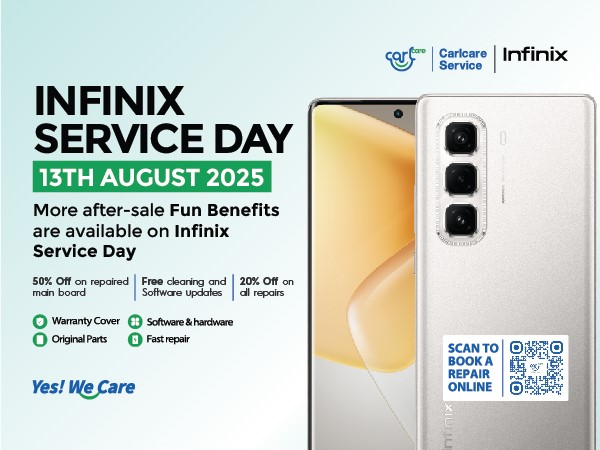
Is your phone camera producing blurry photos, showing a black screen, or refusing to focus properly? You're not alone. Camera malfunctions are among the most common smartphone issues in Kenya, affecting over 65% of device users according to our Carlcare service center data from 2024. Whether you're in Nairobi's dusty environment or dealing with Mombasa's humid coastal conditions, this comprehensive guide will help you diagnose and fix camera problems on TECNO, Infinix, and itel devices.
As Kenya's official after-sales service partner for these leading smartphone brands, Carlcare has repaired over 50,000 camera-related issues across our service centers. This expert guide combines professional technician insights with practical DIY solutions specifically tailored for Kenya's unique environmental challenges.
Common Camera Issues Affecting Kenyan Smartphone Users
Camera problems in Kenya often stem from environmental factors unique to our diverse climate zones. Our technicians have identified four primary categories of camera malfunctions that account for 87% of all repair requests at Carlcare service centers nationwide.
Dust and Humidity Effects on Camera Lenses
Kenya's varied climate zones create specific challenges for smartphone cameras. In arid regions like Northern Kenya and parts of Eastern Province, fine dust particles infiltrate camera modules through micro-gaps around lens assemblies. This dust accumulation causes gradual image quality degradation, with photos appearing hazy or lacking contrast.
Coastal areas including Mombasa, Malindi, and Lamu present humidity-related challenges. Salt-laden air accelerates corrosion of camera components, while high moisture levels cause lens fogging. Our Mombasa service center reports 40% higher camera repair rates during the rainy seasons (March-May and October-December).
The highland regions around Nairobi, Nakuru, and Eldoret experience rapid temperature fluctuations that cause condensation inside camera modules. This moisture can damage delicate electronic components and create persistent focus problems.
Camera App Crashes and Black Screen Problems
Software-related camera failures represent 35% of all camera issues reported to Carlcare Kenya. These problems typically manifest as camera apps failing to launch, frequent crashes during photo capture, or persistent black screens when switching between front and rear cameras.
TECNO's HiOS camera app may freeze when insufficient storage space prevents image processing. Infinix XOS systems occasionally experience camera service conflicts with third-party photography apps. Itel's lighter Android Go version sometimes struggles with camera functionality when system memory is low.
Blurry Photos and Focus Issues
Auto-focus problems plague smartphone users across Kenya, particularly affecting social media enthusiasts who rely on sharp, Instagram-ready photos. Our repair data shows focus issues peak during dusty seasons when lens mechanisms become contaminated.
Mechanical auto-focus failures typically require professional repair, but 60% of reported focus problems stem from software calibration issues that users can resolve through settings adjustments or app resets.
Front Camera Problems Affecting Video Calls
With remote work becoming prevalent in Kenya's tech hubs, front camera functionality has become critical. Video conferencing apps like Zoom, Microsoft Teams, and WhatsApp video calls stress front camera modules beyond typical usage patterns.
Common front camera issues include poor low-light performance, inverted images, and microphone synchronization problems during video calls. These issues particularly affect professionals in Nairobi's technology sector and students participating in online learning programs.
Environmental Factors Specifically Affecting Cameras in Kenya
Kenya's diverse geographical regions present unique challenges for smartphone camera longevity. Understanding these environmental stressors helps users take preventive measures and extends camera lifespan significantly.
Mombasa's Humid Coastal Environment
Mombasa's tropical climate creates challenging conditions for smartphone cameras. The combination of high humidity (averaging 75-85%) and salt-laden ocean air accelerates corrosion of metal camera components. Our Mombasa Carlcare service center has documented specific failure patterns unique to coastal environments.
Salt air infiltration causes white crystalline deposits on camera lenses, creating permanent spots in photos. These deposits cannot be removed through standard cleaning and require professional lens replacement. The estimated cost for lens replacement ranges from KSH 3,500 to KSH 8,000 depending on the device model.
Humidity also causes adhesive failure in camera module assemblies. Lens elements may shift position, causing permanent focus problems. Prevention strategies include using waterproof cases and storing devices in low-humidity environments when possible.
Dust Ingress in Arid Northern Regions
Northern Kenya's arid climate presents different challenges. Fine dust particles, smaller than 10 micrometers, penetrate camera assemblies through microscopic gaps. This dust accumulation occurs gradually, making detection difficult until image quality severely degrades.
Our Garissa and Isiolo service points report seasonal spikes in camera repairs coinciding with dry seasons and strong winds. Pastoralist communities face particular challenges as livestock movement creates additional dust exposure.
Dust-related camera damage typically requires complete module replacement rather than cleaning. Prevention through protective cases and regular maintenance significantly reduces repair needs.
Temperature Fluctuations in Highland Areas
Nairobi, Nakuru, and other highland regions experience daily temperature swings of 15-20 degrees Celsius. These fluctuations cause condensation inside camera modules as warm, humid air contacts cool internal surfaces.
Condensation damage manifests as temporary lens fogging, focus drift, and eventual corrosion of electronic components. Our Nairobi service centers see increased camera repairs during transitional seasons when temperature variations peak.
Users can minimize condensation damage by allowing devices to acclimate gradually when moving between temperature extremes and avoiding camera use immediately after temperature changes.
Urban Pollution Impact on Camera Performance
Major urban centers including Nairobi, Mombasa, and Kisumu present air quality challenges that affect camera performance. Vehicle emissions, industrial pollution, and construction dust create fine particulate layers on camera lenses.
Urban pollution requires more frequent cleaning maintenance compared to rural environments. However, improper cleaning with abrasive materials causes micro-scratches that permanently reduce image quality.
DIY Camera Troubleshooting for Kenyan Conditions
Before seeking professional repair services, users can resolve approximately 45% of camera issues through systematic troubleshooting. These solutions address common problems while considering Kenya's specific environmental challenges.
Cleaning Techniques for Kenya's Dusty Environment
Proper camera cleaning requires specific materials and techniques to avoid damage. Start by powering off the device completely and removing any protective case. Use compressed air to remove loose dust particles, directing airflow away from camera openings to prevent forcing debris deeper into mechanisms.
For lens cleaning, use microfiber cloths specifically designed for optical surfaces. Standard cloths may contain abrasive fibers that scratch lens coatings. Apply minimal pressure using circular motions from the center outward.
Never use household cleaners, alcohol, or water directly on camera lenses. These substances can damage anti-reflective coatings and seep into internal mechanisms. If persistent spots remain after dry cleaning, seek professional service rather than risk damage.
Software Solutions for Camera App Issues
Software-related camera problems often resolve through systematic troubleshooting steps. Begin by force-closing the camera app and clearing its cache through device settings. This resolves temporary glitches and frees up processing resources.
For TECNO devices running HiOS, navigate to Settings > Apps > Camera > Storage > Clear Cache. Infinix XOS users should access Settings > Application Manager > Camera > Clear Cache. Itel devices follow standard Android procedures through Settings > Apps & Notifications > Camera > Storage > Clear Cache.
If cache clearing doesn't resolve issues, restart the device to refresh system processes. Persistent problems may require factory reset, but backup all data before proceeding as this process erases all user information.
Check available storage space, as insufficient memory prevents photo capture and causes app crashes. Maintain at least 2GB free space for optimal camera performance, particularly when recording videos or using advanced photography features.
Settings Optimization for Different Lighting Conditions
Kenya's intense equatorial sunlight and rapid day-night transitions challenge automatic camera settings. Manual optimization improves photo quality significantly across varying conditions.
For bright outdoor conditions common throughout Kenya, reduce exposure compensation by -0.5 to -1.0 stops to prevent overexposure. Enable HDR mode for scenes with strong shadows, particularly useful for architectural photography in urban environments.
During golden hour photography popular among Kenya's social media users, increase saturation slightly and adjust white balance to "daylight" for warmer tones. Night photography requires manual focus and extended exposure times when available.
Indoor photography under artificial lighting benefits from custom white balance settings. Fluorescent lights common in offices require "fluorescent" white balance, while LED lighting may need "daylight" or custom calibration.
Storage Management for Photo and Video Capture
Smartphone storage management becomes critical for users who frequently capture photos and videos. Kenya's vibrant social media culture generates substantial multimedia content that quickly fills device storage.
Implement automatic cloud backup through Google Photos, OneDrive, or manufacturer-specific services. Enable backup only on WiFi connections to avoid expensive mobile data charges. Most Kenyan internet service providers offer unlimited WiFi packages suitable for photo backup.
Regularly review and delete duplicate photos, blurry images, and unnecessary videos. Use built-in gallery management tools to identify similar photos and select the best versions for retention.
Consider transferring photos to external storage or computers periodically. USB OTG cables allow direct transfer to flash drives without computer requirements, useful for users with limited computer access.
Brand-Specific Camera Solutions for Popular Kenyan Smartphones
Different smartphone brands require specific troubleshooting approaches based on their camera implementations and software customizations. Our Carlcare technicians have developed brand-specific solutions based on repair experience across Kenya's diverse user base.
TECNO AI Photography Features Troubleshooting
TECNO's AI-powered camera features enhance photography but occasionally malfunction due to software conflicts or insufficient processing power. AI scene detection may incorrectly identify subjects, resulting in inappropriate color processing or focus errors.
Disable AI features temporarily to isolate camera hardware problems. Access camera settings and turn off "AI Scene Detection" and "AI Beauty" modes. Test basic camera functionality without AI enhancements to determine if issues persist.
TECNO's portrait mode relies on dual-camera systems for depth sensing. Dirt or damage to secondary cameras causes portrait mode failures even when primary cameras function normally. Clean both camera lenses thoroughly and test portrait mode with high-contrast subjects for optimal depth detection.
Night mode on TECNO devices requires steady hands and adequate lighting for optimal results. Use tripods or stable surfaces for long exposure shots. If night mode consistently produces poor results, recalibrate the camera through settings reset.
Infinix Camera Enhancement Settings
Infinix XOS includes advanced photography features that enhance creative capabilities but may cause confusion for casual users. The "Super Night" mode requires specific techniques for optimal results in Kenya's varying lighting conditions.
Ultra-wide-angle lenses on Infinix devices are particularly susceptible to distortion and chromatic aberration in bright lighting. Use standard focal lengths for important photos and reserve ultra-wide for creative applications where distortion adds artistic value.
Infinix's zoom features may struggle with focus hunting in low light conditions common during evening social gatherings. Pre-focus on subjects before zooming and avoid excessive zoom levels that degrade image quality.
Video stabilization on Infinix devices consumes significant battery power and may cause overheating during extended recording sessions. Monitor device temperature during video recording and use external cooling if necessary for long sessions.
Itel Camera Optimization and Photo Quality Improvement
Itel devices target budget-conscious users but still provide capable camera performance when optimized correctly. The key lies in understanding hardware limitations and working within optimal parameters.
Itel cameras perform best in good lighting conditions. Avoid indoor photography without adequate lighting and use device flashlight for close-up subjects. The small sensor size requires careful exposure management to prevent noise in shadows.
Image processing on itel devices is conservative to maintain performance on limited hardware. Users seeking enhanced photos should consider third-party camera apps that provide manual controls, though these may impact performance on entry-level processors.
Battery optimization features may limit camera performance to extend usage time. Disable aggressive power saving modes during photography sessions to ensure full camera functionality, particularly for video recording applications.
When to Seek Professional Camera Repair Services
While DIY solutions resolve many camera issues, certain problems require professional diagnosis and repair. Recognizing these situations prevents further damage and ensures safe, effective repairs that maintain device warranty coverage.
Identifying Hardware vs Software Issues
Hardware failures typically manifest as persistent problems that survive software resets and updates. Physical damage indicators include cracked camera glass, loose camera modules, or visible moisture inside lens assemblies.
Software issues usually appear suddenly after app updates, system changes, or new app installations. These problems often affect multiple camera functions simultaneously and may resolve through systematic troubleshooting steps.
Intermittent problems suggest loose connections or failing hardware components. These issues require professional diagnosis as they may worsen over time and cause secondary damage to related systems.
Carlcare's Professional Camera Repair Expertise
Carlcare technicians receive specialized training on TECNO, Infinix, and itel camera systems directly from manufacturers. This expertise ensures accurate diagnosis and proper repair procedures that maintain device integrity and warranty coverage.
Our service centers stock genuine camera modules and lens assemblies sourced directly from manufacturers. Counterfeit parts may appear identical but lack quality control and longevity of genuine components.
Professional repairs include calibration procedures that ensure optimal camera performance after component replacement. DIY repairs cannot replicate these calibration processes, potentially resulting in ongoing performance issues.
Carlcare provides warranty coverage on all camera repairs performed at authorized service centers. This warranty protects customers against premature failure and ensures repair quality meets manufacturer standards.
Understanding Repair Costs and Options
Camera repair costs vary significantly based on damage extent and device model. Simple lens cleaning or software recalibration typically costs KSH 500-1,500, while complete camera module replacement ranges from KSH 3,500-12,000.
Front camera repairs generally cost less than rear camera repairs due to simpler mechanisms and lower component costs. However, devices with advanced front camera features may require expensive specialized components.
Consider device age and value when evaluating repair costs. Repairs exceeding 40% of device replacement cost may not provide economic value, particularly for older devices with limited remaining useful life.
Carlcare offers trade-in services that provide credit toward new device purchases when repair costs exceed reasonable thresholds. This service helps customers transition to newer devices while minimizing financial impact.
Protecting Your Camera Long-Term in Kenya's Environment
Preventive maintenance significantly extends camera lifespan and reduces repair needs. Implementing protective strategies tailored to Kenya's environmental challenges provides the best long-term value for smartphone investments.
Selecting Appropriate Protective Cases
Quality protective cases provide essential camera protection without compromising functionality. Choose cases with raised edges around camera modules to prevent direct contact with surfaces during placement.
Waterproof cases benefit users in humid coastal areas or during rainy seasons. However, ensure cases maintain proper heat dissipation as trapped heat can damage internal components during extended use.
Dust protection requires cases with precise port coverage that prevents particle infiltration while maintaining accessibility. Silicone plugs for charging ports and headphone jacks provide additional protection in dusty environments.
Avoid cases with magnetic closures near camera areas as magnetic fields can interfere with optical image stabilization systems and auto-focus mechanisms.
Environmental Protection Strategies
Store devices in controlled environments when possible, particularly overnight when temperature and humidity fluctuations peak. Simple storage containers with desiccant packets provide protection in humid areas.
Avoid temperature shock by allowing gradual acclimation when moving between air-conditioned spaces and outdoor environments. This practice prevents condensation formation inside camera modules.
Regular maintenance schedules should include gentle cleaning every two weeks in dusty environments and monthly in urban areas. Consistent maintenance prevents accumulation that requires professional intervention.
Establishing Regular Maintenance Routines
Develop systematic maintenance habits that become second nature. Weekly visual inspection of camera lenses and monthly function testing help identify problems before they become serious.
Document camera performance through test photos that allow comparison over time. Gradual quality degradation may not be noticeable day-to-day but becomes apparent when comparing images across weeks or months.
Keep device software updated as manufacturers frequently release camera performance improvements and bug fixes. Enable automatic updates when connected to WiFi to ensure latest optimizations.
Monitor available storage space and maintain adequate free space for optimal camera performance. Set calendar reminders for monthly storage cleanup and photo backup activities.
Frequently Asked Questions About Camera Repairs in Kenya
Why do phone cameras fail more frequently in Kenya compared to other countries?
Kenya's diverse climate zones create unique challenges for smartphone cameras. Coastal humidity, highland temperature fluctuations, and arid region dust infiltration stress camera components beyond typical design parameters. Our service centers report 30% higher camera failure rates compared to temperate climates due to these environmental factors.
How much does professional camera repair cost at Carlcare service centers?
Camera repair costs depend on damage extent and device model. Basic cleaning and calibration services range from KSH 500-1,500, while complete camera module replacement costs KSH 3,500-12,000. We provide free diagnostic services to determine exact repair requirements and costs before proceeding with any work.
Can I claim warranty coverage for camera problems caused by environmental damage?
Warranty coverage depends on specific circumstances and damage causes. Manufacturing defects remain covered under standard warranty terms, while physical damage or misuse typically requires paid repair services. Our technicians evaluate each case individually to determine appropriate coverage options.
How long does professional camera repair take at Carlcare centers?
Simple software-related repairs typically complete within 2-4 hours, while hardware replacements require 1-3 business days depending on parts availability. We offer repair status tracking through our website and mobile app to keep customers informed throughout the repair process.
Should I attempt DIY camera repairs to save money?
DIY repairs risk additional damage and warranty voiding. We recommend professional service for hardware issues while software troubleshooting can be attempted safely. Our phone repair services ensure proper diagnosis and quality repairs that maintain device integrity.
Which camera problems can I fix myself vs requiring professional help?
Software issues, basic cleaning, and settings optimization can typically be handled through DIY methods. Hardware problems including cracked lenses, loose camera modules, or water damage require professional repair to prevent further damage and ensure proper resolution.
How can I prevent camera problems in Kenya's challenging environment?
Use quality protective cases, avoid temperature shock, implement regular cleaning routines, and store devices in controlled environments when possible. Prevention costs significantly less than repair and maintains optimal camera performance throughout device lifespan.
Taking Action: Next Steps for Camera Problems
Don't let camera problems prevent you from capturing Kenya's beautiful moments and staying connected with family and friends. Whether you're dealing with blurry photos, black screen issues, or focus problems, solutions are available through both DIY troubleshooting and professional repair services.
Start with the software troubleshooting steps outlined in this guide, as these resolve approximately 45% of camera issues without requiring repair costs. If problems persist after systematic troubleshooting, professional diagnosis ensures accurate problem identification and cost-effective solutions.
Carlcare's network of authorized service centers across Kenya provides convenient access to expert camera repair services. Our technicians understand the unique challenges facing smartphone users in Kenya's diverse environments and provide solutions tailored to local conditions.
Book a repair appointment online to save waiting time, check warranty coverage for your device, or locate the nearest service center for immediate assistance. Professional camera repair ensures your device returns to optimal performance while maintaining warranty protection and long-term reliability.
For additional support, explore our comprehensive repair tips and guides or contact our customer service team for personalized assistance with your specific camera concerns.
This guide represents Carlcare's commitment to supporting Kenya's smartphone users through expert repair services and comprehensive technical support. As the official after-sales service partner for TECNO, Infinix, and itel, we combine manufacturer expertise with local environmental knowledge to provide the best possible solutions for camera repair and maintenance needs.


















